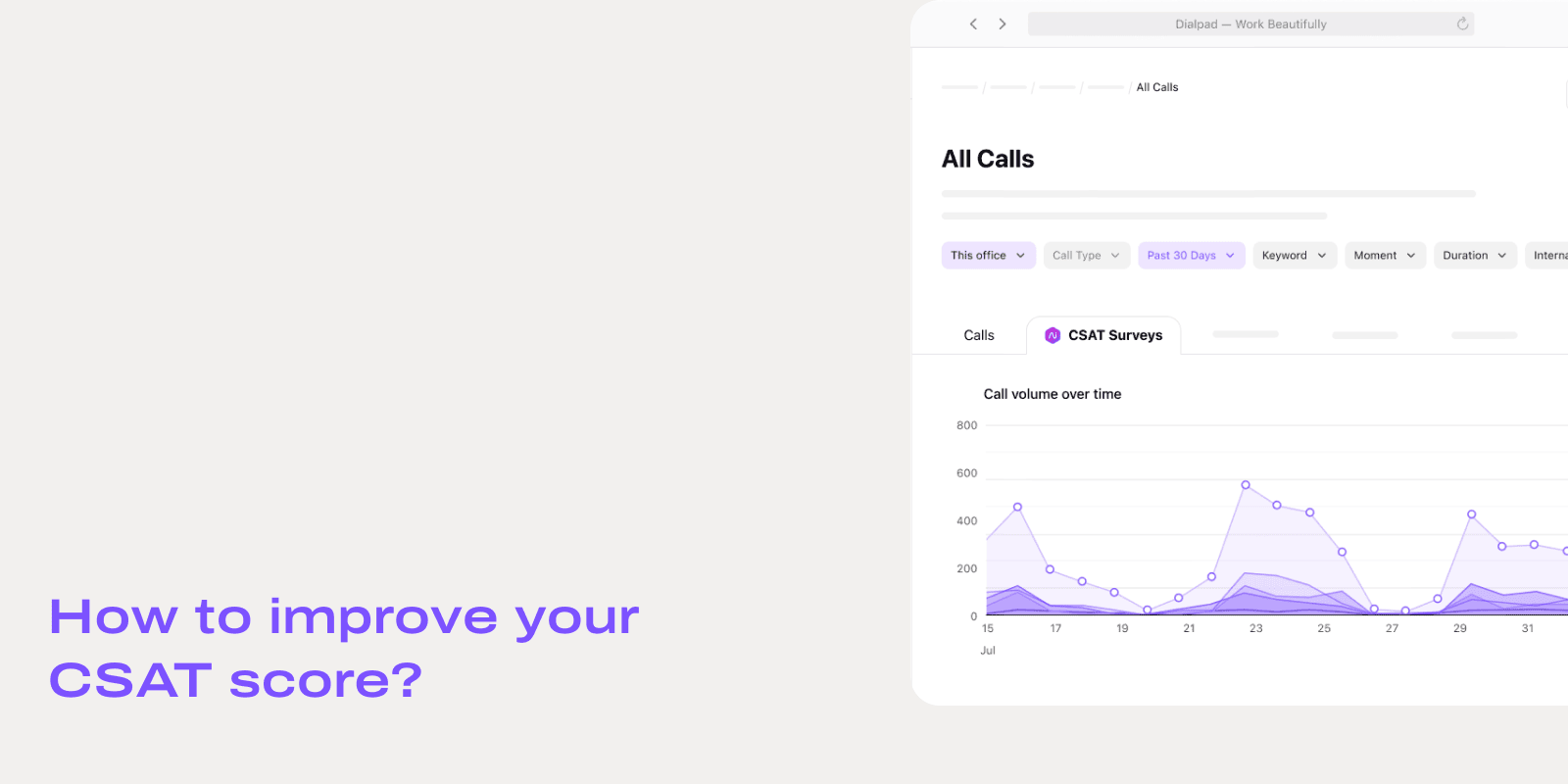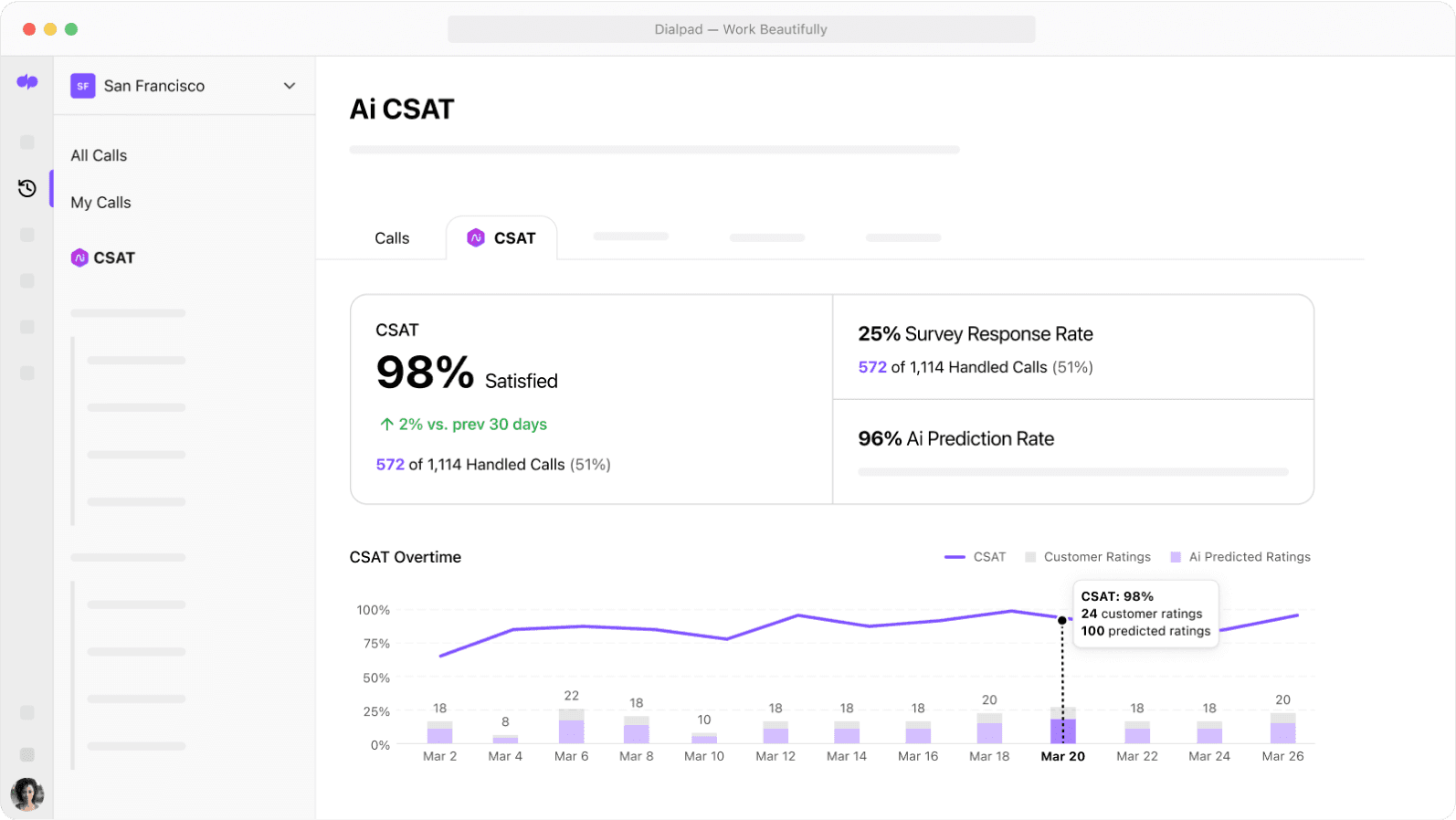How to improve your call center CSAT score in 4 steps: A Guide from a VP of Support

VP of Support

Tags
Share
One of the biggest tasks for any support organization, no matter what industry you’re in, is to provide a good customer experience. And one of the most important metrics that’ll help you gauge and improve your CX are CSAT scores.
But what should you pay attention to as you’re collecting customer satisfaction feedback and more importantly, how can you take concrete steps to improve your CSAT scores?
I’ll walk you through how to do both in this guide below based on my experience leading our Support org here at Dialpad.
How to improve CSAT scores in a call center (in 4 steps)
Step 1: Know your CSAT score
First things first, you need to know what your CSAT score is before you can try to figure out how to improve it. Your CSAT score reflects how satisfied your customers are on average with your company’s support, so just knowing it will tell you if you’re already on the right track (or have a lot of work to do).
However, this is easier said than done, because the most key aspect of understanding CSAT is often the hardest to get: actual customer responses. Traditionally, companies can figure out their CSAT based on customer surveys taken after the call. So how many customers typically stay on the line to answer the survey? 50 percent? 20 percent?
According to our own research, try closer to three percent.
And those survey respondents tend to be the extreme cases—either the most satisfied or dissatisfied customers who either have a lot to complain about or really want to praise the agent for going above and beyond. Customers who had a perfectly average call don’t tend to stick through the survey.
So, this means we’re only getting to see how a tiny fraction of customers were satisfied or not, and they don’t represent the average call. You simply can’t get a very accurate score that way.
Enter Ai CSAT.
Dialpad’s Ai CSAT feature gives you a much bigger sample size because it can predict CSAT for 100% of our customer interactions:

This allows you to get a much more clear and accurate view of your CSAT, rather than just the few edge cases.
Step 2: Identify the detractors
Next thing you need to be able to do is easily identify the detractors. Historically, this was done by looking at individual CSAT scores that customers provide and reading the comments. Dialpad’s Ai CSAT also makes this easier, since it includes a red indicator to clearly mark who the detractors are.
Why identify the detractors first? Well, as painful as negative feedback can often be, it’s important to understand where your agents are falling short. Those interactions with detractors will help you get to the “why”—the reasons your agents might be getting low CSAT scores. Which brings us to the next step…
Step 3: Identify the "why" behind low CSAT scores
Let’s say you’re a Support leader and your CSAT score is 80%. You can’t positively impact that 20% of customers who feel negatively about you—unless you understand what it was about the interactions that caused that 20% of customers to feel dissatisfied.
Again, Dialpad's call summary feature makes it easy to spot them. Let’s say it’s a voice call. Historically, checking phone calls has been a very inefficient way to review customer interactions, because you have to listen to the whole call from beginning to end. With Dialpad, you can easily spot key moments in the transcript:

The end result: you get to do more, faster.
👉 Quick sidenote:
I'd say a call recording feature is a minimum/table stakes. Transcripts are even better and more useful because they let you review calls even faster.
The future we’re envisioning at Dialpad as we build out our cloud contact center platform: artificial intelligence that can help you spot detractors—and tells you why the customers were dissatisfied, without you even having to review the call.
Was it a long wait time, long resolution time, lack of agent knowledge, or something else? AI could potentially tell you off the bat. Imagine how many hours a week that would save you.
Step 4: Categorize the negative detractors and learn from the calls
After you gather all the detractors, the last step is to determine what you can learn from them. I have a QA team go through and bucket the reasons for low CSAT scores. The output should be a pie chart or waterfall chart that tells you which soft skills or categories are causing low CSAT. These are your biggest opportunities.
Right now, my QA team goes in every week and looks for opportunities to coach agents. They’ll review the transcript or listen to the call if needed, or jump to the key moments in the AI transcript, and keep track of it all in a spreadsheet. We’re hoping to improve that process even more by using AI to make it less manual and more automated.
Either way, I now have clear-line insight into the biggest opportunities to improve our customer experience. This saves us a tremendous amount of time and allows us to make informed data-driven decisions when implementing changes. All of those call recordings and transcripts give you new insights into ways you can improve your team’s training and make sure they’re ready for the next caller with a similar issue, so they can provide the best possible help.
Since implementing Ai CSAT, we’ve increased our own Ai CSAT scores by 13%! That’s spectacular, because as most support leaders know, moving CSAT even by 1% is often very difficult.
As a support leader, when you don’t have these tools, it’s hard to know where to start. The alternative to something like Ai CSAT is almost always something that’s much less effective and less efficient. For example, you might be looking through every single ticket, or sending out a poll to your support team and asking the agents where the opportunities are—I used to do this. And it’s incredibly time-consuming.
The larger the company, the more data there is to review. It’s a monumental task. Imagine sifting through tens of thousands of tickets a month and being able to easily spot the why. Now imagine how much easier the task becomes when Ai CSAT automatically identifies those tickets and issues for you—just the time savings alone are a significant change for the better!
How will you improve your call center CSAT scores?
One major step to providing an amazing customer experience is understanding what can cause a poor one. That requires feedback from customers, identifying where things went wrong, and understanding how they can be improved.
Sure, all those steps could be done manually, by asking customers to answer surveys and searching through them one by one to find where the problems lie. But that’s time-consuming and inefficient. Ai CSAT, on the other hand, helps you gain a fuller understanding of how your customers feel and identify the detractors, so you can quickly see what needs improvement and why.
From there, it’s just a matter of understanding the customers’ complaints and working on addressing them. Follow these four steps and you’ll see your CSAT scores start to rise.
Improve CSAT scores in your call center now
Discover how Dialpad's AI-powered customer intelligence platform can help agents and supervisors provide an amazing customer experience. Get a demo, or take a self-guided interactive tour of the app on your own first!








